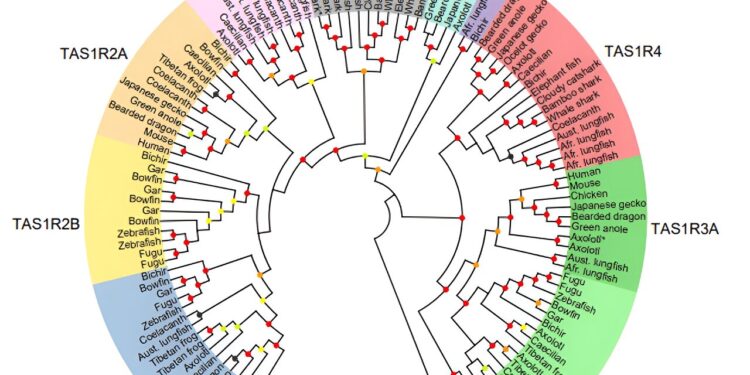A new study led by researchers at Kindai University has identified five new groups of umami and sweet receptors within the TAS1R family (TAS1R4, 5, 6, 7, And 8) as well as the diversity of the TAS1R2 and TAS1R3 genes. Credit: Hidenori Nishihara of Kindai University
Taste perception is one of the most important senses and helps us identify beneficial foods and avoid harmful substances. For example, our penchant for sweet and salty foods results from our need to consume carbohydrates and proteins. Given their importance as an evolutionary trait, researchers around the world are studying the origin and evolution of taste receptors over time. Obtaining this information about the feeding behavior of organisms can help them build a picture of the history of life on Earth.
One of the important tastes in our taste palette is umami, or savory taste, associated with proteins which are an essential part of the diet of many organisms. Taste receptor type 1 (T1R) detects sweet and umami tastes in mammals. This taste receptor is encoded by TAS1R, a gene family including TAS1R1, TAS1R2, and TAS1R3, and comes from a common ancestor of bony vertebrates.
However, this genetic pattern is not observed in coelacanth and cartilaginous fish, where “taxonomically unplaced” TAS1R genes have been identified, suggesting an incomplete understanding of the evolutionary history of taste receptors.
However, a research team led by Associate Professor Hidenori Nishihara of Kindai University and Professor Yoshiro Ishimaru of Meiji University in Japan has identified five new, previously unknown groups within the TAS1R family. This discovery is the result of a genome-wide study of jawed vertebrates, including all major fish groups.
The study, published in Ecology and evolution of nature on December 13, 2023, includes contributions from Senior Assistant Professor Yasuka Toda of Meiji University, Professor Masataka Okabe of Jikei University School of Medicine, Professor Shigehiro Kuraku of the National Institute of Genetics, and Professor associate of the Shinji Okada project at the University of Tokyo.
“Our study found that, compared to most modern vertebrates, the vertebrate ancestor had more T1Rs. These results challenge the paradigm that only three members of the T1R family have been conserved during evolution.” , explains Professor Nishihara.
The color key indicates the names of the different members of the T1R. Solid, colored circles on the branches indicate the presence of TAS1R members, while open circles indicate their absence. Arrowheads above open circles indicate that the TAS1R member was lost at the branch. Credit: Hidenori Nishihara of Kindai University
The new taste receptor genes, named TAS1R4, TAS1R5, TAS1R6, TAS1R7 and TAS1R8 by the researchers, were classified based on their distribution among species with a common ancestor. The researchers found that TAS1R4 genes were present in lizards, axolotls, lungfish, coelacanths, bichirs and cartilaginous fish, but absent in mammals, birds, crocodilians, turtles and teleost fish . Additionally, the axolotl, lungfish, and coelacanth have TAS1R5.
Researchers observed a close evolutionary relationship between TAS1R5, TAS1R1, and TAS1R2, indicating shared ancestry between these genes. Cartilaginous fishes exclusively possess TAS1R6. In particular, the researchers discovered that TAS1R6 had evolved from the same ancestral gene that led to the TAS1R1, TAS1R2 and TAS1R5 genes. While axolotls and lizards have TAS1R7, bichirs and lungfishes have TAS1R8. The researchers determined that these two genes came from the common ancestor of jawed vertebrates.
In addition to these new genes, the study revealed diversity in existing TAS1R genes. For example, they found that vertebrate bone TAS1R3 could be divided into TAS1R3A and TAS1R3B. TAS1R3A was present in tetrapods and lungfish, while TAS1R3B was identified in amphibians, lungfish, coelacanths, and ray-finned fish. Furthermore, the genomic study revealed that TAS1R2 diversified into two distinct clusters (TAS1R2A and TAS1R2B), challenging the conventional idea that TAS1R2 forms a single gene cluster.
“We found that the TAS1R phylogenetic tree includes a total of 11 TAS1R clades, revealing unexpected genetic diversity,” adds Professor Nishihara.
The results also suggest that the first TAS1R gene appeared in jawed vertebrates approximately 615 to 473 million years ago. The gene then underwent several duplications to produce nine taste receptor genes (TAS1R1, 2A, 2B, 3A, 3B, 4, 5, 7, and 8) in the common ancestor of bony vertebrates. Over time, some of these genes were lost in different lineages, with mammals and teleosts retaining only three TAS1Rs (TAS1R1, TAS1R2A, and TAS1R3A in mammals).
In addition to shedding light on evolutionary history, the results also have practical applications. Explaining this to us, Professor Nishihara says: “These results allow us to more easily infer the taste preferences of various vertebrates. This, in turn, may have potential applications such as the development of pet foods and attractants tailored to the preferences of fish, amphibians and reptiles.
More information:
Hidenori Nishihara et al, A catalog of T1R receptors at the vertebrate level reveals diversity in taste perception, Ecology and evolution of nature (2023). DOI: 10.1038/s41559-023-02258-8
Provided by Kindai University
Quote: Untangling the evolutionary origins of umami and sweet taste preferences (December 29, 2023) retrieved December 29, 2023 from
This document is subject to copyright. Apart from fair use for private study or research purposes, no part may be reproduced without written permission. The content is provided for information only.



